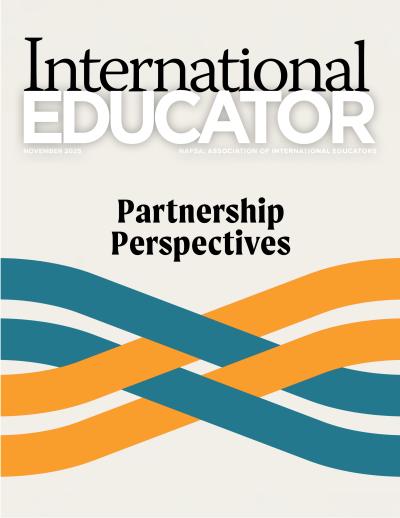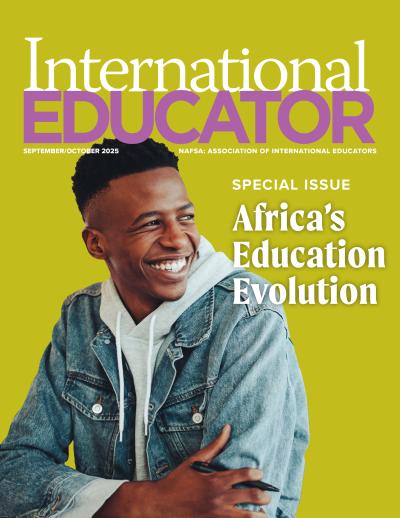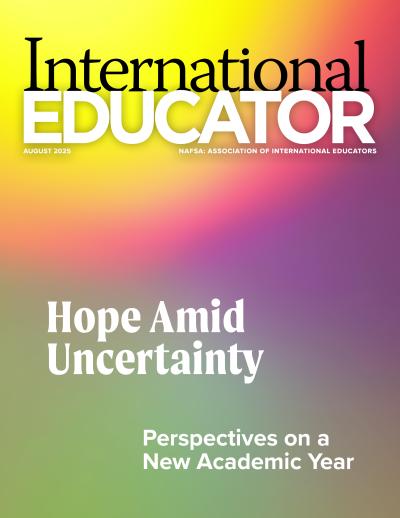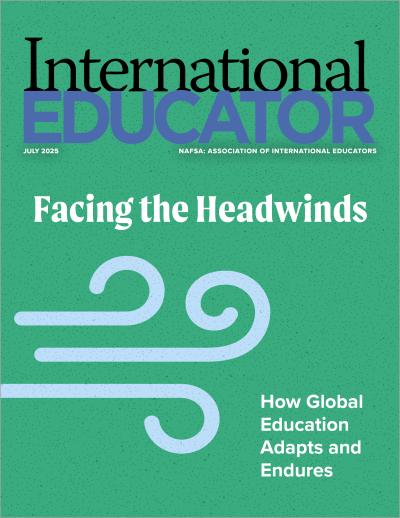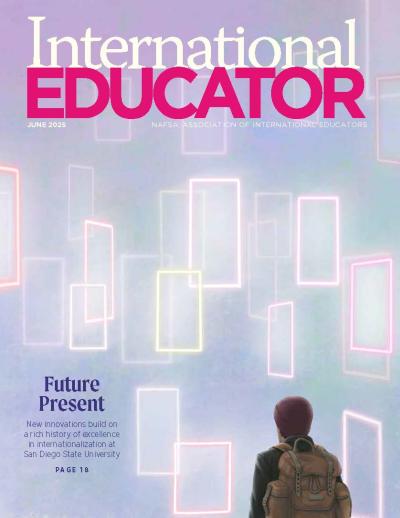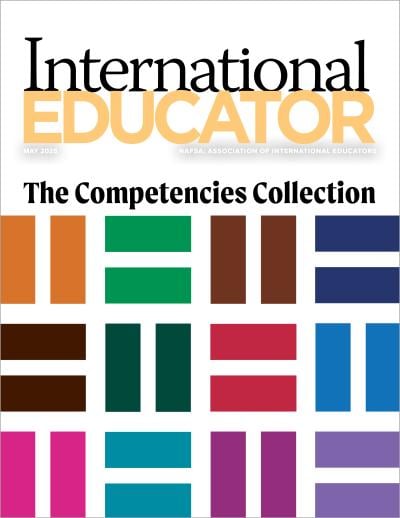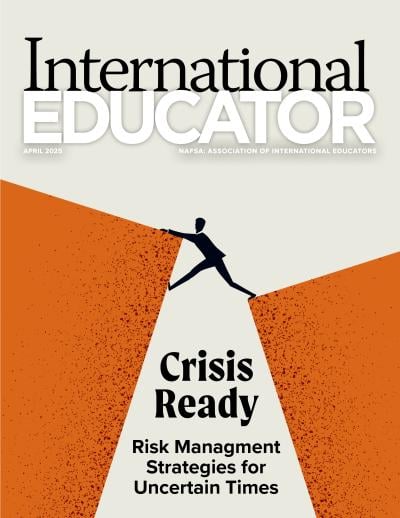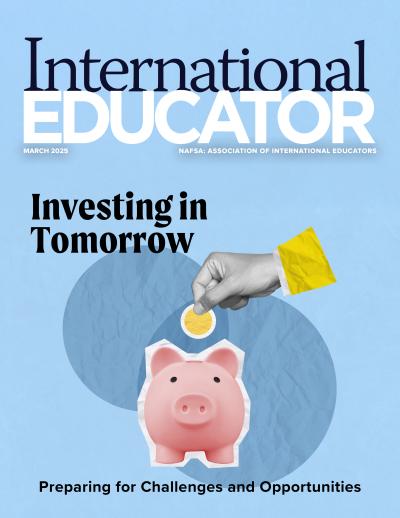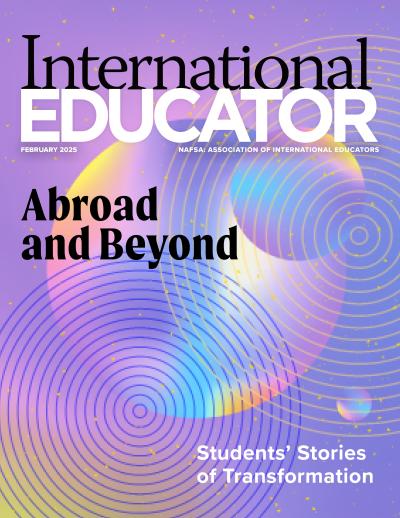Future Present
“Transcend borders, transform lives.”
Tucked into the strategic plan of San Diego State University (SDSU), the statement is as much a reflection of the California institution’s geography as it is of its mission.
Located about 20 miles from the U.S.-Mexico border, the university has some students who cross the border daily to attend classes. They may wake up at 3:00 or 4:00 a.m. to pass through the border checkpoint in San Ysidro in time to make it to SDSU’s campus for classes.
From supporting transfronterizo students and their peers from nearly 120 countries to developing locally focused partnerships at institutions from the Pacific Rim to the Caucasus, SDSU has taken an international approach to education since its founding in 1897. Now, its Global Campus unit is charting new ground in virtual international education, building online programming to “equip students to take on the world’s toughest problems—not someday but right now,” as SDSU Global Campus Dean Ian Gibson puts it. In doing so, the school is attempting to address virtual barriers that have proven as challenging as physical ones.
“At the heart of our work is the belief that borders should never be barriers to education,” Gibson says. “We’re trying to come at this with every tool, every technology, everything we can to be as accessible as possible….The work has never been as important as it is now.”
A Global Tradition: “International in our DNA”
SDSU has had “international in our DNA from the beginning,” says Gibson. SDSU was in the inaugural cohort of institutions honored with NAFSA’s Senator Paul Simon Award for Campus Internationalization in 2003, but many of its international efforts go back decades earlier.
At a time when many intensive English programs are closing across the nation, SDSU’s American Language Institute has been in continuous operation for more than half a century. “It’s an anchor point in the international education sphere,” Gibson says. The institute is part of SDSU Global Campus, which has served more than 50,000 students from 10 countries.
Many of the university’s efforts across the globe have focused on developing educational opportunities while avoiding “brain drain” in developing regions. For more than 30 years, SDSU has operated the Center for Pacific Studies, which supports education programs in Pacific Island nations so teachers and administrators “can stay home and build the economic potential of their nations,” Gibson says.
In 2014, the university founded SDSU Georgia through a partnership between the government of the country of Georgia, the U.S. State Department, and the Millennium Challenge Corporation. The partnership is part of a $140 million grant program to improve STEM education in the former Soviet republic. A collaboration with three Georgian institutions—Georgian Technical, Ilia State, and Tbilisi State Universities—SDSU Georgia offers internationally accredited bachelor’s degrees to support the country’s engineering and science fields.
“At the heart of our work is the belief that borders should never be barriers to education. We’re trying to come at this with every tool, every technology, everything we can to be as accessible as possible….The work has never been as important as it is now.” —Ian Gibson
Over the past decade, the collaborative partnership has graduated about 600 students—nearly half of them women—and trained more than 120 Georgian faculty members to localize STEM education “in the context of Georgia,” Gibson says.
“With this program, you get the chance to learn in your own country and get the same opportunities and valued knowledge as you would get abroad,” Ani Shalamberidze, a former student, wrote of her experience with the program. “More Georgians will have the opportunity to be competitive for STEM jobs and to be successful in their own country. I think that there is a bright future for all the STEM majors in this new generation of Georgians.”
Gibson says a key to the program’s success is its local context. SDSU Georgia’s three local university partners have developed their own accredited degree programs that have created a “huge ripple effect” for the institutions and, more broadly, the region’s STEM capacity and economic development.
SDSU invests not only in educational opportunities on other continents but in ones closer to home. The university has also prioritized partnerships with counterparts in the neighboring Mexicali region and elsewhere in Mexico for decades, and new collaborations continue to be formed. In May 2022, SDSU opened the Oaxaca Center for Mesoamerican Studies in Mexico.
The selection of the Oaxaca region for the center was intentional—it holds the highest percentage of Native and Indigenous language speakers in Mexico, mirroring a similar dynamic in San Diego County. The county is home to the largest number of Native and Indigenous tribes in the United States, and California has the country’s largest concentration of Indigenous Mesoamerican communities. These parallels have created an environment ripe for cross-cultural collaboration in Oaxaca.
“With this program, you get the chance to learn in your own country and get the same opportunities and valued knowledge as you would get abroad.” —Ani Shalamberidze
Along with serving as a site for interdisciplinary research and collaboration, the center offers a global health internship, during which SDSU health sciences students can travel to Oaxaca for hands-on experiences as well as Indigenous language studies.
Another offering focused on U.S.-Mexico ties is the RE:BORDER conference. Hosted and organized by SDSU for the past seven years, the conference brings together institutions from across the Cali-Baja regions of the United States and Mexico to discuss cross-border collaboration. When the conference has been hosted on SDSU’s campus, participating students from Mexican universities would board buses at 2:00 a.m. to cross the border in time for opening sessions. “It spoke volumes about the dedication and value these international learners are seeing,” Gibson says.
The Current Moment: New Modalities and Full-Circle Recognition
Like many U.S. institutions, SDSU has seen a rebound in global exchange following the COVID-19 pandemic: There was a 40 percent increase in the number of students going abroad in spring 2025 compared with prepandemic levels. SDSU Global Campus is now focusing on the largest roadblocks for prospective inbound international students: access and affordability.
“Coming to Southern California is not a hard sell,” Gibson says. “But the cost of living is so significant that it’s the primary barrier for students who want to study with us but ultimately are not able to.”
In response, SDSU Global Campus has created a new modality for international programs. GlobalFlex uses a master’s-degree format that allows students in three-semester programs to study virtually from their home country for the first semester. They then travel to San Diego for the remaining two semesters—which allows them to qualify for Optional Practical Training and the on-campus services offered to all SDSU students. The first cohort of GlobalFlex students are now in their first semester of classes in San Diego.
“They saved money, and there’s no compromise with the curriculum—it’s the same faculty,” Gibson says.
This year, SDSU has come full circle in national recognition of its internationalization efforts. Having received an inaugural Simon Award in 2003, SDSU was selected for its second Comprehensive Award in 2025. SDSU was honored for its work in producing global-ready graduates, modernizing its international affairs unit, investing in binational and global education diplomacy initiatives, strengthening platforms to help international students transition to the U.S. higher education system, and advancing other internationalization initiatives.
Vision for the Future: Breaking Through Virtual Borders
As it looks to continue reducing barriers to educational access, SDSU Global Campus is now “building something new,” Gibson says, with virtual programming that offers a fresh model for exchange and collaboration.
Called IMPact (Inspire, Mobilize, Prepare, and Act) Projects, the interdisciplinary online learning modules focus on the United Nations Sustainable Development Goals (SDGs). With projects in three disciplines—humanities, STEM, and international relations—for each of the 17 SDGs, the modules are designed to bring together cohorts of students from around the world who are working to solve “intractable problems” such as hunger, water use, gender inequality, and climate change.
“We’re offering up a portfolio of project-based curricula designed for tangible outcomes,” Gibson says. “The ‘act’ piece is important to us—higher education for a long time has been overly focused on theory without jumping into its application. These projects are all about application.”
For example, the modules focused on SDG 2—Zero Hunger—include projects promoting food waste reduction strategies, sustainable agricultural practices, nutrition education, and healthy eating habits.
“The ‘act’ piece is important to us—higher education for a long time has been overly focused on theory without jumping into its application. These projects are all about application.” —Ian Gibson
The IMPact Projects are designed to attract students from multiple disciplines. For example, another module deals with water issues through a local lens, encouraging students to explore how an encampment of unhoused people is contributing to cleanliness issues along a nearby river.
“If you’re a marketing major, you need a strategic communication strategy. An education major would say, ‘We need programs to bring people back to gainful employment,’ while engineering students might be thinking about treatment systems,” Gibson says. “We’re using the SDGs as the foundational framework….[W]hatever might speak to someone, there will be a collaborative discovery process to say what this looks like locally.”
Designed in partnership with ed tech provider Coursera, the projects also address long-standing “roadblocks when it comes to [the] virtual in international education,” says Jesús Rosario, Coursera’s senior partnerships director for the Pacific, western states, and the Midwest.
Coursera and SDSU worked together to address what Rosario calls “the infrastructure challenge” of virtual education. Collaborations “can be cumbersome to design [and] labor-intensive for faculty—and [it’s] difficult to bring two groups together,” he says.
The IMPact modules include resources and technology to address these issues. Leveraging Coursera’s generative artificial intelligence–powered course-building tool, IMPact allows participating faculty to use existing content to customize and create new modules that meet their needs and local contexts. Faculty can use the tool to “prompt a course into existence by using the ones that have already been created. That intersection is where the magic happens.”
IMPact will also include a matchmaking function to help faculty find counterparts in other countries who are interested in pursuing similar goals, along with real-time translation capabilities to support student and faculty collaboration. “We’re working to bring in a large ecosystem of universities in order to have a critical mass of students for every one of these projects so faculty can jump in and get going quickly,” Gibson says.
According to Rosario, these efforts can reduce the time needed to establish a collaborative module from between four and six months to a week or less, making collaborations “more accessible, affordable, and scalable.”
Unlike earlier models of virtual exchange and collaboration, which require faculty partners at different institutions to find each other and collaborate in a specific discipline or content area, IMPact is designed to bring together students from a wide range of institutions and interests.
“It’s not one institution going to a visiting institution. It levels [the playing field] so it doesn’t feel like one’s hosting and the other’s the guest.” —Jesús Rosario
“We’re creating a whole ecosystem around this to take that barrier to entry and make it as small and frictionless as possible,” Gibson says. “The courses can scale up like a MOOC [massive open online course]. Whatever the needs are for each project, they can be flexible enough to reach these tangible outcomes without being wedded to the academic calendar.”
SDSU is also working with Coursera to address another pain point in virtual international education: incompatible learning management systems across multiple universities. “It can be cumbersome to find a platform where you can authenticate securely across two different content systems,” Rosario says. The Coursera platform acts as a neutral intermediary, which, along with interoperability, provides another, more subtle, benefit.
“It’s not one institution going to a visiting institution,” Rosario says. “It levels [the playing field] so it doesn’t feel like one’s hosting and the other’s the guest.”
But the technology remains secondary to collaboration—and the end goal of the IMPact projects. Through IMPact and its other partnerships and initiatives, SDSU Global Campus’s focus remains squarely on ensuring students are globally minded and prepared to meet the needs of an increasingly interconnected and complex world, according to Gibson.
“I would never bet against our students in coming up with what the world needs,” he says. “It’s our job to provide them with a framework with the tools and resources to proceed.”
Keys to Innovation: Components of SDSU’s Approach
Focus on accessibility and relevance. Addressing cost issues and ensuring programming meets global employment needs are “first principles” for SDSU Global Campus, but they also extend beyond the international office. “Those are common threads through everything we’re doing, but they’re not any different than how we are thinking about serving domestic students,” Gibson says. “Financial pressures and tailored solutions are universal needs.”
Embrace risk. Coursera’s Rosario gives SDSU credit for partnering with the technology provider to create its model for virtual collaboration. “We work in an industry that’s very risk averse when it comes to technology and innovation,” he says. “We’re at a pivotal point in human history where things are moving rapidly, and we don’t have a lot of answers about what higher education will look like two or five years from now. There’s always a risk, but the alternative is even more costly.”
Respect the local context. SDSU’s history in the Pacific Rim, Mexico, and Georgia highlights the importance of working with local partners and contexts instead of “copying and pasting our way of thinking,” Gibson says.
Turn crisis into opportunity. Fears of new restrictions on international mobility can provide what Gibson calls “inflection points” to serve global students in new ways. “I’m looking for the opportunities,” he says. “If we approach them with the right mindset, we might be able to see the regulatory fulcrum as a prism that opens up new ways to operate.”
Measure impact. Gibson recalls visiting partner universities in India and seeing posters of graduates on the wall, listing where each was hired after graduating—and their salaries. “You couldn’t imagine any more transparent way of measuring success,” he says. “International students are budgeting down to the dollar, and they’re seeing this very much as an investment and an inflection point in their professional lives. We have a moral obligation to be as transparent as possible.”
Share ideas and strategies. Gibson sees open sharing as a “momentum builder” for the field as a whole. “We don’t want to see it steeply decline,” he says. “The solution is to be open, transparent, and extremely collaborative and let the best ideas win.” •
About International Educator
International Educator is NAFSA’s flagship publication and has been published continually since 1990. As a record of the association and the field of international education, IE includes articles on a variety of topics, trends, and issues facing NAFSA members and their work.
From in-depth features to interviews with thought leaders and columns tailored to NAFSA’s knowledge communities, IE provides must-read context and analysis to those working around the globe to advance international education and exchange.
About NAFSA
NAFSA: Association of International Educators is the world's largest nonprofit association dedicated to international education and exchange. NAFSA serves the needs of more than 10,000 members and international educators worldwide at more than 3,500 institutions, in over 150 countries.
NAFSA membership provides you with unmatched access to best-in-class programs, critical updates, and resources to professionalize your practice. Members gain unrivaled opportunities to partner with experienced international education leaders.


